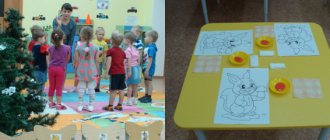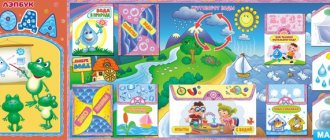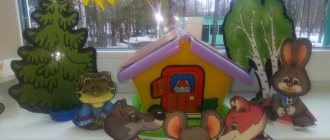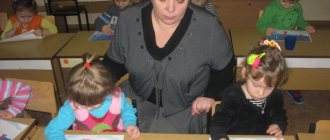Summary of a lesson on ecology in the second junior group “Wonderful Water”.
Urban district city of Vyksa
MUNICIPAL BUDGETARY PRESCHOOL EDUCATIONAL CENTER
INSTITUTION
combined kindergarten No. 7 “Golden Fish” 607060, Vyksa, st. Kornilova building 97,
8(83177) 3 – 55 – 11, email: [email protected]
Lesson notes
in ecology in the junior group of kindergarten
"Wonderful Water"
Completed by: teacher of the highest qualification category Krasotkina M.A.
Goals:
1. Clarifying children’s ideas about the importance of water for all living things: plants, animals, humans.
2. A story about the importance of water in our lives. To give children the first basic knowledge about the water cycle in nature.
Tasks:
1. Educational objectives.
Give children knowledge about the properties of water (taste, color, smell).
2. Developmental tasks.
Develop hand-eye coordination, memory, attention.
3. Educational tasks.
Cultivate an attentive and caring attitude towards nature.
Material:
cups of boiled water according to the number of children, 3 transparent cups, one cup of salt water, one of sweet water, cups of warm and cold water.
Progress of the lesson:
To the music, a teacher in a “Water” costume enters under a blue umbrella and greets the children.
Educator: Hello, guys! I came to visit you.
I am a cloud, and a fog, And a stream, and an ocean, And I fly, and I run, And I can be glass!
Very good-natured, I am soft, obedient, But when I want, I will even wear out a stone.
I am not stone, not sand,
My son is a trickle
You guessed it, friends,
What's my name? (Water)
Poem about water
Author: Svetlana Olegova What is water?
What is water? This is a trickle from a tap, These are waves and storms on the seas and oceans. There is a drink in the hand in a sweaty bottle, And in the spring, and in the well, and in the stream.
Yes, water can be in different states. In liquid, solid it. Even in gaseous form. We don't see it or don't notice it. But when it’s not there, we feel it hard.
Educator: What is water for, how do we use it? (we drink, wash our hands, bathe, do laundry, wash the floor, water the flowers).
Educator: Guys, where does the water come from when we wash ourselves? That's right, from the tap. But to get to our house, water travels a long way. Look - this is a fontanelle. The fontanel is small, it flows out of the ground. And a cheerful stream flows from the spring. Let's play trickle with you.
Outdoor game "Streams".
Educator: a stream flows and ends up in a river. The river is small at first, and then it gets bigger and bigger. The river flows into the sea. The sea is very large, the waves crash against the shore. Listen to music. (Music is playing).
While we were playing, you probably got thirsty, come to the table, look, here’s the water, I suggest you guys taste the water. (Children are offered boiled water, each). What is she like? Sweet? Salty? Bitter?
Message from work experience “Methods and techniques of environmental education with children of the younger group”
Just like a small tree that barely rises above the ground, a caring gardener strengthens the root, on the power of which the life of the plant depends for several decades, so a teacher must take care of instilling in his children feelings of boundless love for the Motherland. The development of these qualities begins from the time when the child begins to see, learn, and evaluate the world around him.
V. A. Sukhomlinsky.
The comprehensive development and upbringing of children is carried out by various means. One of them is familiarization with nature. Nature is an inexhaustible source of spiritual enrichment. The infinitely diverse world of nature awakens keen interest and curiosity in children, encourages them to play, work, and art. However, not everything can be correctly understood by children when communicating with nature on their own, and their relationship with plants and animals is not always formed correctly. Introducing a child into the world of nature, forming realistic ideas about its objects and phenomena, cultivating the ability to see the beauty of native nature, love, a careful and caring attitude towards it - this is one of the most important tasks of the kindergarten.
Preschool childhood is the initial stage of the formation of a person’s personality, his value orientation in the world around him. During this period, a positive attitude towards nature, towards the “man-made world”, towards oneself and the people around them is formed.
The main content of environmental education is the formation in a child of a consciously correct attitude towards natural phenomena and objects that surround him and with which he becomes acquainted in preschool childhood.
In order for the world to appear beautiful and spiritual to our children, so that we, adults, have different ideas about it, we must help them with this.
I think that only a living experience received in childhood and associated with ideas about the value of life of all living things around, who are also capable of feeling pain, can change the attitude towards our Green House. Since the knowledge gained from the first years of life can later be transformed into strong beliefs.
When starting to work on this topic, we set ourselves the goal of educating environmentalists, giving them basic environmental knowledge, teaching them mercy, and instilling in them a love for living things. In addition, we strive to develop in children the skills and abilities to care for plants and animals.
In our group, there are mainly newly arrived children from home and only 7 children who transferred from the first junior group. During the first month, we observed the children, had conversations with them: looked at pictures depicting domestic and wild animals and their cubs, talked about birds, insects and their appearance, looked at trees, shrubs, flowers, looked at paintings depicting the seasons, talked about the benefits of fruits, vegetables and berries, etc. As a result of observations, we came to the conclusion that there are children in the group who cannot name all the animals and their babies, not everyone knows the names of the seasons, cannot identify natural phenomena from a picture, do not name birds, do not distinguish a tree from a bush, and they can’t name them, not everyone knows the names of vegetables, fruits, and berries. Children have a poor stock of active vocabulary. It turned out that there is not a single child with a high level of knowledge, three children with an average level of knowledge, and the rest - low. Thus, we outlined the following tasks:
— Teach the child to perceive the world around him through understanding the laws of natural processes.
— Continue to introduce domestic animals and their cubs, the characteristics of their behavior and their nutrition.
— Expand your understanding of wild animals (bear, fox, squirrel, hedgehog, etc.), and amphibians (using the example of a frog).
— Learn to watch birds flying to the site (crow, pigeon, tit, sparrow, bullfinch, etc.), feed them in winter.
— Expand children’s understanding of insects (butterfly, May beetle, ladybug, dragonfly, etc.).
— Learn to distinguish and name vegetables, fruits and berries by appearance.
- Give basic ideas about the plants of the area: trees, flowering herbaceous plants (dandelion, coltsfoot, etc.). Show how indoor plants grow, give an idea that plants need soil, water and air to grow.
- To introduce the characteristic features of successive seasons and the changes that occur in connection with this in the life and activities of adults and children.
- Give an idea of the properties of water, sand, snow.
— Learn to reflect received impressions in speech and productive activities.
— Develop aesthetic feelings, the ability to see and feel the beauty of the nature of the native land.
-To instill in children a desire to participate in feasible work caring for plants and animals.
We plan and carry out work on environmental education in the organized educational field “Cognitive development” in accordance with the program “From birth to school” edited by I.E. Veraksy, T.S. Komarova, M.A. Vasilyeva, based on the recommendations of S.N. Nikolaeva and O.A. Solomennikova.
We carry out environmental education with preschoolers in accordance with the Federal State Educational Standard for Education, integrating educational areas - “Cognitive development”, “Speech development”, “Art. aesthetic development”, “Social and communicative development”, “Physical development”.
We conduct educational activities 1-2 times a month, and we organize joint activities with children daily through various forms of work (observations, work in nature, reading fiction, games of various types, etc.)
In order for environmental education to be carried out constantly and purposefully, it is very important to create an appropriate subject-development environment. First of all, this is a corner of nature in the group. When selecting the inhabitants of a corner of nature in our group, we took into account, first of all, the peculiarities of children’s perception of objects (kids highlight bright signs and properties), as well as educational tasks. To familiarize children with plants, we placed ficus, geranium, and coleus in a corner of nature, where you can clearly see the stem, leaf and flower, and for comparison we added a violet, which has only flowers and leaves. Seasonal objects were brought in: twigs, bouquets of leaves of various trees, flowers, herbs. We designed a weather calendar and its methodological support (cards depicting the time of year, day, weather features), sets of pictures depicting animals, birds, insects, etc., and the album “Seasons”. A place has been allocated for crafts made from natural materials, there is also material for labor, and natural and waste materials for crafts.
To enrich children's knowledge we use a large number of board and printed games. We produced and systematized didactic games and manuals with environmental content: “Who is this?”, “Collect a picture”, “Who lives where?”, “Who needs water?”, “Whose cub?”, “Zoological lotto”, etc.
In the book corner we selected literature according to the age of our children: poems and fairy tales about animals and birds, books about vegetables, colorful illustrations.
In our work to introduce children to nature, we use different methods in a complex, correctly combining them with each other:
— Visual methods. These include observation, viewing educational films, pictures, and demonstrations of various models. This group of methods allows us to form certain bright and stable images in the child’s mind. The practice of working with preschoolers shows that they easily become recognizable and form very specific ideas about the surrounding nature in children.
— Practical methods. These rightly include playing, modeling and conducting the most basic experiments and experiments. This group of methods helps us consolidate existing knowledge and enrich ourselves with new ones; while playing, children learn to build simple logical chains. In addition, practical methods make it possible to actively form the value orientations of a preschooler.
— Verbal methods. Of course, these are stories from the teacher, conversations with children, reading literature with environmental overtones, and stories from the children themselves. The use of these methods allows us to form a humane and emotionally positive attitude towards nature and systematize the knowledge gained.
Environmental education of preschool children takes place continuously in the process of educational activities and in everyday life.
The concept of “everyday life” provides for the process of raising children at different regime moments. From the point of view of environmental education, the morning hours (before breakfast), when children come from home, are the most important - this is the most suitable time for activities in a corner of nature. We draw children's attention and show how to care for plants: we teach how to water a flower, wipe large leaves with a damp cloth, involving them in simple labor actions (for example: we teach how to hold a watering can correctly, pour water carefully and accurately). In the process of caring for plants, we learn to look at plants and distinguish them by appearance. To consolidate knowledge about indoor plants, we conduct didactic games: “Find the same”, “Find a plant with large and small leaves”, “Guess by the description”. While walking, we observe the trees and flowers in the flower beds, highlighting the main parts. In joint activities with the teacher, we play didactic and outdoor games.
We pay special attention to observations while walking. For example: when getting acquainted with seasonal changes, we observed the trees, the sky, the rain, the sun, flower beds, and people. They continued to introduce the characteristic features of the autumn period, introduced them to the distinctive features of the leaves of maple, oak and birch, and how the color of the leaves changes. We played games “Which tree is the leaf from?”, “Find the same leaf”, “Wind and leaves”, etc. They suggested collecting autumn bouquets from unusual leaves. Together we organized collective work to clear autumn leaves from the site, examined ripe seed buds in flower beds, and then collected them together. During the observations, we paid attention to the seasonal clothes of people, how they changed, and suggested dressing the dolls for a walk according to the season.
To consolidate the acquired knowledge, we looked at subject pictures, illustrations and plot paintings. Pictures make it possible to examine natural phenomena in detail and to focus attention on them for a long time, which is often impossible to do with direct observation due to the dynamism and variability of nature. The purpose of using paintings is to form in children an aesthetic attitude towards nature, the ability to see its beauty, perceive the figurative and artistic meaning of the painting, and see vivid means of expression.
To cultivate positive emotions in our work, we use the artistic word: we introduce Russian poetry (A. Pleshcheev “Autumn”, I. Belousov “Autumn”, I. Bunin “It’s Raining”, N. Nekrasov “Before the Rain”), read children’s literature . After reading, we have a conversation, clarify the content of what we read and consolidate knowledge, ask questions.
During complex and thematic classes, children were asked to decorate a tree with autumn leaves using an unconventional drawing technique.
While introducing the children to vegetables and fruits, we observed what grew in the vegetable garden and kindergarten. We looked at how carrots and beets grow, how zucchini and pumpkin grow in the garden, how the apples ripen on the trees. We had a conversation about how you can only eat washed vegetables and fruits. We carried out the d/i “Test the taste”, “Wonderful bag”.
To consolidate knowledge, when looking at images in pictures, we give comparative characteristics by shape, size and color, solving problems in other educational areas.
We were introduced to the fairy tale “Turnip,” which we staged with great pleasure using the characters’ hats.
We continue to introduce children to some domestic animals, the peculiarities of their movement, behavior and nutrition; we give basic concepts about the dog’s home (kennel); We form a sense of responsibility for the animals that live next to humans.
During the walk we observed people walking with their dogs and cats who came into the garden. The group looked at manuals about domestic animals and their cubs, introduced them to some of the features of animal life (what they eat, what sounds they make - a horse neighs, a pig grunts, a dog barks, a cat meows...)
The consolidation of knowledge is facilitated by various games (role-playing, active, didactic), as well as the staging of fairy tales in which different animals are found.
In didactic games, children clarify, consolidate, and expand existing ideas about objects and natural phenomena, plants and animals. Didactic games promote the development of attention, memory, observation, activate and enrich the vocabulary.
In our group, children make contact much more actively during the game, easily and with pleasure perceive new information, consolidating the knowledge they have already acquired. In the game "Travel", where we play the role of a tour guide, guide or traveler, and children are participants in the events taking place. Children listen to environmental fairy tales with great interest. An ecological fairy tale teaches scientific vision, helps to reveal complex natural phenomena in an entertaining way, gives the child the opportunity to become a member of an interesting society of loyal friends (animals, plants), and learn to understand their needs and relationships with the environment. Factors such as the availability of material and a fascinating form of storytelling with elements of mystery play an important role. Based on the knowledge that children receive through an ecological fairy tale, the initial forms of a consciously correct attitude towards nature, interest in its knowledge, sympathy for all living things, the ability to see the beauty of nature in its various forms and manifestations, and express their emotional attitude towards it are laid.
During walks and other special moments, we systematically plan and carry out individual work on environmental education: these include didactic games, looking at a picture, and reading art. liters.
Nurturing children's correct attitude towards nature and the ability to carefully handle living beings can be fully implemented in the preschool period only if the system of work in kindergarten is combined with the impact on children in the family.
We advised parents to draw their children’s attention to the beauty of the surrounding nature. They explained that during observations, horizons, curiosity, attention, and thinking expand. And you don’t need to set aside any special time for this. Just look around on the way to kindergarten or home.
Visual information for parents also helps to attract the attention of parents to the environmental education of their children. Consultations were offered on “Walks in nature - the basis of a child’s health”, “Games with environmental content”, a list of children’s literature was proposed that will help in the environmental education of children, and together with parents they made a herbarium from tree leaves. We hope that our joint work will yield good results.
To summarize, I would like to note that educational activities with more active children are always fruitful, dynamic, and they easily cope with the requirements of the program. But it is more difficult to work with newly arrived children; more individual work is required. Our task for the future is to try to help these children be more active. We will continue our work on environmental education.
Junior group. Early childhood, nursery. Children 1-4 years old
Poster "Take care of nature." Collaborative activities between teachers and young children
Poster "Take care of nature "
. Joint activities of a teacher with young children. From an early age, children need to be instilled with the concept that the planet is our common home, we need to take care of it, protect it with all our might: we need to protect the air we breathe, we need to save the water that...
Summary of the lesson on ecology “Take care of nature” (second junior group) In MBDOU 288, group 5, environmental lessons were held as part of the All-Russian campaign “ Ecolyats - Young Nature Defenders ”. While working with children, we touched on the topic “Take care of nature ,” formed a responsible attitude towards nature , increased the level of environmental ...




